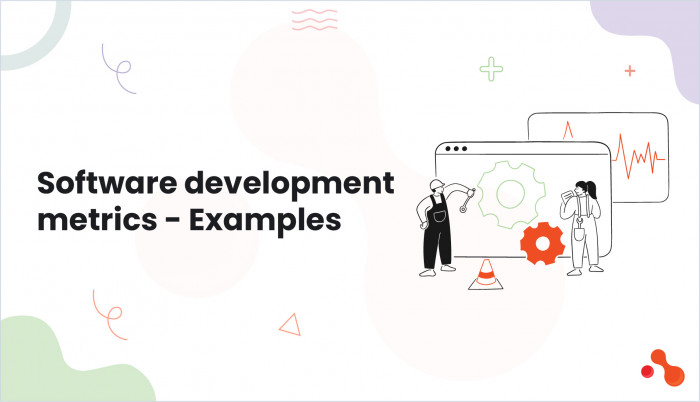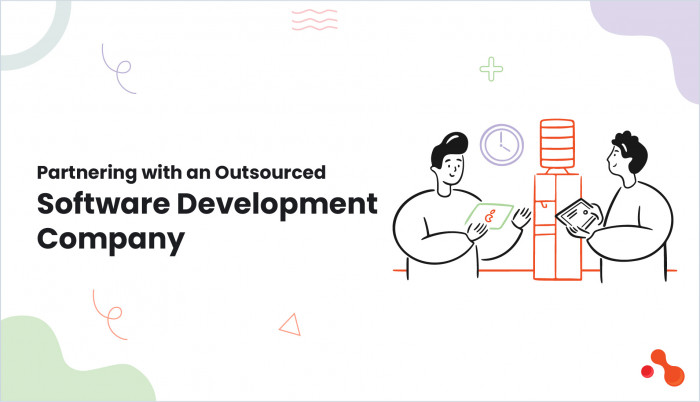Introduction
Evaluating the overall productivity of your team should always be on top of your list if you are a project manager. This article will talk about the key software development metrics and KPIs to identify the potential scope for improvement.
Thanks to the agile methods, the importance of measuring the overall productivity of a software team has increased slightly. Businesses are now keen to adopt software development metrics and have also started monitoring different KPIs to manage the quality gaps within the software product.
A software metrics is a key way of measuring quantifiable and countable characteristics of any software. The main aim here is to determine the quality of the current product or the process, plan work iterations and identify any potential areas for improvement.
Read this article to learn how you can measure essential aspects of your software development process. This article will talk about the basics of software metrics and would determine the important ones at length.
Let’s begin with understanding What are Software metrics?
What are Software Metrics?
A software metrics is a standard of measure which comprises various activities to estimate a software’s testing effort quality, progress and health. For example, the UX, process, formal code, functional, test metrics, etc will be helpful in setting clear business objectives and track software performance.
The right metrics here will allow you to measure the code complexity and productivity to streamline the project management. As a result, you can understand when your development team does best of their work, identify the bottlenecks in the project, reduce the risk elements and eliminate any forthcoming failure.
You can combine your management activities with software metrics to plan an impactful procedure, keep your production team informed, make an effective software maintenance plan and ultimately simplify development projects.
Now, further let us understand why you should track software metrics?
Why should you track software metrics?

By implementing an actionable data strategy across the complete software development life cycle is a sure shot method to innovate and improve the software. As a product owner, you need to look at the baseline data of your development team to experiment with the existing process and workflow.
Below are a few reasons for tracking software development metrics
- To evaluate the quality, health and progress of software testing
- To analyze the associated risks and flow efficiency
- To reduce frequent code changes and ensure a better stability in code.
- To understand whether the expected software quality was achieved or not?
- To improve team collaboration within a healthy work environment
- To plan allocation for resources and reduce the workload of team
Now, moving next let’s learn about how we can track software metrics?
How to track software metrics?
Tracking software development metrics is important for all tech leaders as it enables them to achieve insights about their team’s performance and drive improvement. Below we’ve mentioned everything you need to have in order to track software development metrics:
- Identify specific areas you wish to improve, such as productivity, quality or delivery time. This clarity will help you in proper metric selection and analysis.
- Choose metrics which align with your goals and offer meaningful insights. We have discussed various metrics to choose from the forthcoming sections of this article.
- Integrate your code repository, project management tools and CI/CD pipelines to collect accurate and real-time data. This will help you minimize manual efforts and ensure data consistency.
- Build benchmarks or set targets for each metric based on the past historical data, industry standards or project-specific requirements. This will enable you to compare current performance against the desired goals and identify the areas for improvement.
- Watch for trends, patterns, or significant changes in the metrics. Identify the areas where the performance is lacking or where the improvement in required Regular analysis would enable timely decision making and corrective actions.
- Conduct and plan retrospective meetings to reflect on the metrics and identify actionable insights. Discuss about success, challenges and room for improvements.
Now, further let’s see a few examples of software metrics.
Software development metrics - Examples

A wide range of software development metrics are available for tracking and measuring different components of the process.
Software metrics include, but are not limited to, developer, operational, test, and agile metrics. Operational metrics concentrate on system performance and dependability, while developer metrics are particular statistics used to evaluate the effectiveness, productivity, and quality of individual developers or development teams.
We'll dive into each metric category in detail as well as explore certain software metrics and their significance for software development in the sections that follow.
Let’s finally begin the discussion about different types of software development metrics.
Developer productivity metrics
This type of metrics is a measurement of a software team’s ability to efficiently design high-quality programs which are performed well and are easier to maintain. This refers to a developer’s productivity during a specific time or criteria.
Below are a few popular developer productivity metrics which you can use -
Work log
Based on information from code commits, open/closed PRs, merging commits, and PR comments, the work log provides insightful information. It facilitates the visualization of labor patterns and interpersonal dynamics. By assisting you in locating bottlenecks, it also makes delivery quicker and with greater vigor.
Intense days
Days that a software engineer or coder contributed code to the development project are indicated as active days.
Churning of codes
Code that is changed or removed soon after it is written is referred to as code churn. It's a measure that shows how frequently a specific section of code is edited. When an engineer finds it difficult to write a particular piece of code, code churn is unavoidable. This is typically caused by a lack of expertise or inadequate team communication.
Now, further let us talk about the operational metrics in software development process
Operational metrics
These metrics are key indicators that will enable you to track your business activities in real time. You can use them to improve your efficiency and reflect on the outcomes of software development.
Apart from this, the operational metrics also show how well a company is able to execute its day-to-day operations.
Below are some popular operational metrics to track your operational efficiency.
Mean Time Between Failures (MTBF)
MTBF metrics determine the average time between repairable failures of any software. The longer the time between unexpected outages, the more reliable the software developed. These metrics will help developers understand how frequent incidents occur and how they can resolve it faster.
For calculating MTBF, you need to divide the total of operational hours in a day with the number of failures which arose. Typically, MTBF metrics are calculated in hours.
Take for an example, if the software product operated for 1500 hours in a particular year. Throughout the year there would have been some 10 unexpected outages in the software. So this would be the MTBF you will get -
1500 / 10 = 150 hours
Mean Time to Recover (MTTR)

A MTTR metric highlights the measurement of the meantime required to troubleshoot and repair the failed software component. It computes the time between the start of the incident and when the system goes into production. MTTR highlights how faster an organization would react to and repair accidental breakdowns.
Below is the formula to calculate MTTR -
Let us understand this with an example. Imagine you spent 100 unplanned hours on troubleshooting software which breaks down into ten times a year. So, your MTTR in this scenario would be -
100 / 10 = 10 hours
Now, the third type of metrics is Test Metrics
Test metrics
These metrics are important for testers, agile teams and QA engineers who wish to advance their testing. The best method to enhance your testing is by opting for a relevant test statistic, setting up a baseline and then tracking your actual performance over the following few days, months or years.
Let’s understand a few types of Test metrics in the forthcoming section
Defect distribution
This metric shows what part of your software is most susceptible to defects. In this type of metrics defects can be categorized based on type, severity, root cause, module, etc.
You can make use of defect distribution charts to understand the distribution and identify the areas for maximum defect removals by using histograms, pie or Pareto charts to help you track where your software efforts should go.
Test economics metrics
Each testing budget consists of people, time, efforts and testing tools. Testing projects have certain limitations when it comes to allocating resources. Therefore, understanding how much time you desire to spend and how much actually got utilized is important.
Schedule variance, cost per bug resolve, Budget variance are a few test economics metrics which offer important insights into budget planning. Moreover, test economics metrics would help you plan a budget for your testing activities and evaluate the overall ROI of testing.
For an example, if your budget is 10000 dollars and consists of ten requirements, then the overall cost of testing one requirement would be -
10000/10 = 1000 USD
The last type of metrics here is “Test team metrics”
Test team metrics
The test team metrics measures outputs and testing work allocation. It is a method of tracking the progress of units within the development. Test team metrics consist of distribution of discovered defects, test cases allocated per team member and defects returned per team member.
Now, further let us understand the fourth type of metrics which is known as “Usability metrics”
Usability metrics
Suppose you developed a robust software, and many people signed up for it. However, they didn’t respond after the initial usage or consider this, your application downloads were higher after a few days of its launch, thanks to spot-on marketing. But the user never bothered to use it, or even worse they uninstalled the app within a week.
Identifying initial conversions are more manageable if you use a good promotional and marketing strategy. But keeping your users engaged and loyal to your software or app requires more than just marketing, as user experience becomes more important.
You can get accurate data about the interaction of end users with the product by understanding how you can measure the user experience. Moreover, you can also adjust your marketing and branding efforts to generate better results by understanding more about user experience.
Below are a few metrics which can help you in analyzing user experience.
User error rate
User error rate metrics helps you in knowing the number of times a user makes a wrong input, for e.g. the number of error opportunities. The user error rate implies improvement within your website or software’s UI/UX design. The higher the error rate the higher the number of usability issues will be.
For example, users often make errors while typing an email id ad without email verification, it will result in an error. Image ten out of every hundred users types an incorrect email address, then the user error rate will be
10 / 100 * 100 = 10%
The solution here could be to implement a proper validation and show an error message by asking them to re-enter the password.
Conversion rate
The conversion rate tells you the number of visitors that have completed various tasks like making a purchase and filling out a contact form, etc.
For example, if 1000 new people are visiting your website but only some 100 of them are completing the signup process, then there is a room for improvement within the product/service offering.
PULSE metric
This metric is more focused on measuring the business performance of the enterprise-grade software. This metric highlights technical or business aspects of the performance. The acronym PULSE stands for Page views, Uptime, latency, seven-day active users, and earnings.
Let us understand about what these terms exactly mean -
- The page view shows the number of visitors on your website.
- Uptime highlights the number of times a server is up and running.
- Latency shows the performance of the infrastructure of your website.
- Seven-day users shows the ability of the product to get repeat users within the initial seven days.
- Earnings show that your product is able to work or not.
Now, moving further let us talk about the agile metrics that can be a game changer.
Agile metrics
Agile metrics are the metrics that will help you identify flaws, understand the workflows in a better way and boost up the project delivery time so that your team focuses on satisfying customers through continuous value delivery.
The most basic agile metrics consist of - open/close rates, throughput, code coverages, lead and cycle time. These metrics enable you to prioritize and focus on a particular business goal without any upcoming distractions.
Agile metrics can break down the entire software project into smaller manageable pieces. As a result, it becomes easy for the software developers to manage every aspect of the process smoothly. Apart from this, agile metrics evaluate various parts of the software development process.
Below are a few important agile metrics which can help you minimize the time to turn an idea into a final product -
Lead and Cycle time
Lead and cycle time is important for agile project metrics which shows how long work items are used in any particular process. Lead time shows the overall time spent in the process - from when requested to the till when delivered.
Whereas, cycle time measures the time the development team would take to work on the request.
Below is the formula to calculate lead time -
LT + Od - Or
Where Lt stands for Lead time, Od stands for Order delivered date and Or stands for Order received date.
Assume for the moment that a consumer orders something on May 15, 2022, and gets it on June 5, 2021.
The lead time is then calculated as follows:
Alternatively, Lt = 21 days, 0 months, 0 years; or Lt = 05.15.2022 – 06.05.2021
Throughput
This metric measures the number of tasks, subtasks, features, bugs, etc. that developers complete within a specific given time in software development. This metric enables project managers to evaluate the work of their team members and understand the workload precisely.
Below is the formula for calculating Throughput -
R = I / T
Here R indicates Throughput rate, I indicates the amount of work and T shows the time.
Let us understand how we can calculate the Throughput rate with an example. Let’s assume your software development team has delivered 144 features within 12 hours of time, then your throughput rate would be -
R = 144 / 12 = 12 features
Net Promoter Score
In 2003, management consultant Fred Reichheld developed the Net Promoter Score, a customer loyalty indicator. It calculates an unambiguous and precise customer satisfaction rate that is comparable across many industries.
Furthermore, the Net Promoter Score evaluates the degree to which a participant would suggest a certain business, item, or service to their family members.
For example, you have released the MVP of your new program. You now wish to ascertain its performance. You then ask 200 users at random to assign a 1 to 10 rating to your software.
The users can be divided into three categories: promoters, detractors, and passives. Respondents who score nine or ten are considered promoters. Detractors provide ratings between 0 and 6, whereas passives award ratings between 7 and 8.
Code coverage
It makes it easier for software engineers to maintain the quality of their code. Additionally, it exposes developers to poor code on a constant basis, which finally maintains higher product quality.
The following formula can be used to determine code coverage:
(Total lines of code in a system component / Number of lines of code performed by a testing methodology) * 100
Let's use an example to help make code coverage more clear.
For example, suppose you have 200 lines of code in your software testing, and 100 of those lines have been validated.
Code coverage will therefore be equal to 100 / 200 * 100 = 50%.
Now, say you are a FinTech based business and you want to outsource software development from a reputed outsourced software development company, then make sure you evaluate all the above mentioned metrics thoroughly to achieve a successful software development project execution.
But, how to do that?
Partnering with an Outsourced Software Development Company

If you want to outsource software development for your Fintech business, it is important to evaluate the key metrics that align with your project goals.
Start by establishing clear and focused Key Performance Indicators which are SMART, i.e. Specific, Measurable, Achievable, Realistic and Time-specific. For example, if your goal is to enhance user engagement in a mobile app, then you might track metrics like user adoption rates and session duration.
Choose metrics that are most important for your objective, avoid unnecessary data that can complicate decision-making. Engage in regular assessments of Agile metrics like cycle time and team velocity to make sure your development process remains efficient.
Partnering with an outsourced software development company can help you implement software development processes in a smoother manner.
Now, let’s understand how Acquaint Softtech can help you in achieving a successful software development outsourcing,
How can Acquaint Softtech help?
Mr. Mukesh Ram's ambition of starting an IT outsourcing business came true in 2013. An Indian company called Acquaint Softtech focuses on IT staff augmentation and software development outsourcing.
At Acquaint Softtech, we specialize in helping business owners and entrepreneurs hire remote developers with the right skills to address skill scarcity in their IT departments.
As an official Laravel partner, we also provide MERN stack development and MEAN stack development services. It's recommended that your organization hire remote developers if it's having problems locating reasonably priced personnel for your in-house team.
Acquaint Softtech provides remote developers for as little as $15 per hour, whether you're looking to hire MEAN stack developers or hire MERN stack developers.
Wrapping up!
Whether you are opting for in-house software development or even if you’re opting for an outsourced software development focusing on software development metrics is essential to improve the quality of your product delivery.
In this article we covered everything that you should analyze before and after the launch of the product to achieve better results and business growth. So, if you’ve a software development idea in mind and if you want to turn the idea into a workable solution to grow your business then opting for an outsourced software development company should be your go-to idea.
Reach out to Acquaint softtech to fulfill your software development needs. Contact us today for any software development requirements or custom web app development requirements our team is always ready to help you!
















